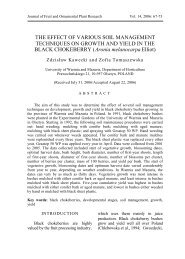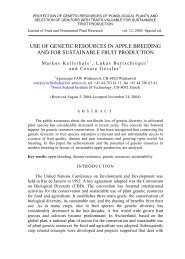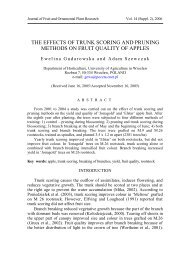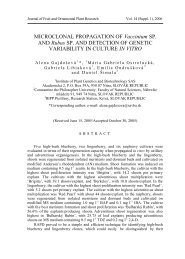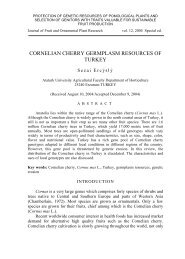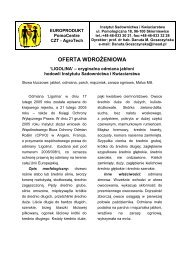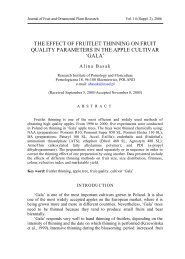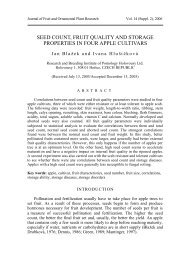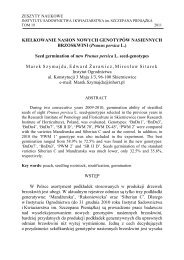Winter-hardy apricots and peaches with good fruit quality in Latvia
Winter-hardy apricots and peaches with good fruit quality in Latvia
Winter-hardy apricots and peaches with good fruit quality in Latvia
Create successful ePaper yourself
Turn your PDF publications into a flip-book with our unique Google optimized e-Paper software.
<strong>W<strong>in</strong>ter</strong><strong>hardy</strong> <strong>apricots</strong> <strong>and</strong> <strong>peaches</strong>…<strong>in</strong> <strong>Latvia</strong>The most promis<strong>in</strong>g apricot <strong>and</strong> peach seedl<strong>in</strong>gs were selected on the basis ofmorphology <strong>and</strong> phenology, <strong>fruit</strong> <strong>quality</strong>, <strong>and</strong> disease resistance. A total of twentycriteria were used <strong>in</strong> select<strong>in</strong>g <strong>apricots</strong>. The criteria were based on descriptor listsapproved by IPGRI (1984) <strong>and</strong> UPOV (1979) for <strong>apricots</strong>, <strong>and</strong> by IPGRI (1985)<strong>and</strong> UPOV (1995) for <strong>peaches</strong>. Local reference cultivars were used for comparison.Eat<strong>in</strong>g <strong>quality</strong> was estimated on the basis of soluble solids content (°Brix).RESULTS AND DISCUSSIONIn <strong>Latvia</strong>, <strong>apricots</strong> are not more widely grown because they do not reliablybear <strong>fruit</strong>, even though the flower bud set is usually abundant. The ma<strong>in</strong> factorlimit<strong>in</strong>g the productivity of apricot trees <strong>in</strong> colder climates is the short deepdormancy period (Straz<strong>in</strong>ska, 1999). The blossom<strong>in</strong>g period <strong>and</strong> the length of thedeep dormancy period vary widely from cultivar to cultivar. Most cultivars have adeep dormancy period that ends at the end of January or the beg<strong>in</strong>n<strong>in</strong>g of February.Apricots go through a forced dormancy period after the deep dormancy periodends. Depend<strong>in</strong>g on the weather <strong>in</strong> a given year, this forced dormancy period couldend as early as the end of January or as late as the end of March (Kaufmane, 1998).The hybrids selected dur<strong>in</strong>g this study had very long deep dormancy periods<strong>and</strong> were not significantly damaged by thaw<strong>in</strong>g <strong>and</strong> subsequent freez<strong>in</strong>g dur<strong>in</strong>g thethird decade of January or the first <strong>and</strong> second decades of February. ‘Lasma’ <strong>and</strong>‘PU16749’ had modest yields even after a w<strong>in</strong>ter <strong>in</strong> which January was warm (10to +5°C) <strong>and</strong> the second decade of February was very cold <strong>with</strong> temperatures downto 29°C.The other ma<strong>in</strong> factor limit<strong>in</strong>g the productivity of apricot trees <strong>in</strong> colderclimates is the early blossom<strong>in</strong>g period. In <strong>Latvia</strong>, <strong>apricots</strong> usually blossom <strong>in</strong> thethird decade of April or the first decade of May. In this study, the earliestblossom<strong>in</strong>g period started on April 18, <strong>and</strong> the latest blossom<strong>in</strong>g period started onMay 10. Depend<strong>in</strong>g on the weather, the blossom<strong>in</strong>g period lasts from 12 to 17 days<strong>in</strong> most years, <strong>and</strong> can last up to 22 days if the weather is exceptionally cool dur<strong>in</strong>gthe blossom<strong>in</strong>g period.The delicate blossoms can be damaged if the temperature falls to 0.5 to 3°Cdur<strong>in</strong>g the blossom<strong>in</strong>g period, depend<strong>in</strong>g on the genotype (Akca <strong>and</strong> Sen, 1999;Draganesku <strong>and</strong> Cociu, 1999; Solovyova, 1967; Straz<strong>in</strong>ska, 1999). The amount ofdamage also depends on how long the temperature stays below this criticaltemperature. If the temperature drops to 2.5 to 2°C for only one or two days, thesepals <strong>and</strong> petals are damaged by frost, but the pistils rema<strong>in</strong> <strong>in</strong>tact. A modest yieldis still possible.Large fluctuations <strong>in</strong> daily temperature can do even more damage. In 1993,when the weather dur<strong>in</strong>g the blossom<strong>in</strong>g period was generally favorable, nighttemperatures dropped to 2°C at one po<strong>in</strong>t, damag<strong>in</strong>g 20 to 100% of the flowerbuds, depend<strong>in</strong>g on genotype. Nevertheless, most genotypes at Dobele had <strong>good</strong>yields that year. Yields may not be significantly reduced even if 20 to 60% ofJ. Fruit Ornam. Plant Res. Special ed. vol. 12, 2004: 321329 325




